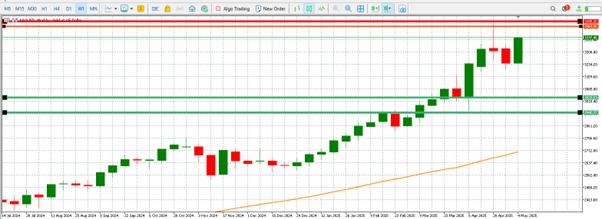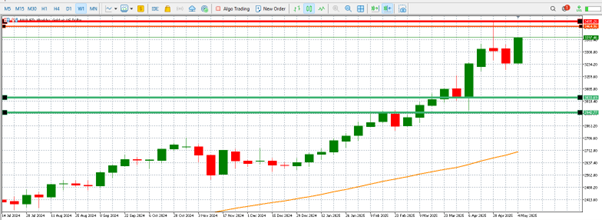Spot gold is currently trading at $3,372.01 per ounce, a 1.2% increase from yesterday. as of this morning. This represents a new high for the precious metal since April 22, which further propels it into uncharted territory. It is important to keep in that gold has recently reached an all-time high of $3,500.05 per ounce, as it did last month. This surge is the result of a variety of economic and geopolitical factors, but three primary drivers are particularly noteworthy: ongoing trade tensions, concerns regarding the dollar's future as the primary global reserve currency, and uncertainty regarding the Federal Reserve's monetary policy.

Gold trading: chart by XTB
The Factors That Influence the Price of Gold
1. Trade Tensions Remain Unresolved
Tariff war between the US and China is still very much anchored in place. This uncertainty has historically motivated investors to seek out safe-haven assets, such as gold, which have been used as a protective measure during periods of instability. This particular factor is keeping investors on edge although there are some initial sings of de-escalation.
2. Apprehensions Regarding the Dollar's Status as a Reserve Currency
The price of the yellow metal is highly linked to the performance of the green back--U.S. currency, as the precious metal is priced in dollars. In recent years, the dollar's long-standing status as the world's reserve currency has been the subject of increasing scrutiny. The future of the dollar as the global benchmark has been called into question by geopolitical changes, including the ascension of China and Russia's advocacy for a multipolar world. The gold price is highly likely to benefit from a declining dollar. Currently, traders have doubt if dollar will remain the main reserve currency. Traders do think that the current narrative of trade war is actually hurting the dollar as a reserve currency. If we see the dollar restoring its status, that may take some shine away from the gold price.
3. The Federal Reserve's Future Monetary Policy
Another critical factor is the uncertainty that exists regarding the Federal Reserve's monetary policy. The trajectory of future rate movements remains uncertain, despite the fact that the Federal Reserve has already implemented a succession of interest rate declines in recent months. Investors are intently monitoring the Federal Reserve's signals, particularly in light of the ongoing economic data. Gold would likely continue to benefit from lower real yields if the Fed signals a pause or further cuts in the near future, as the opportunity cost of holding non-yielding assets like gold becomes more attractive. Nevertheless, the presence of any unforeseen hawkish remarks could result in a decline in gold prices, as the dollar would be bolstered by higher interest rates, which would render bonds more appealing to investors.
Forthcoming Events for Gold: FOMC Meeting and US CPI Data
The trajectory of gold is expected to be significantly impacted by two significant events in the near future: the publication of U.S. CPI data next week and the impending FOMC meeting tomorrow. The short-term price of gold and the broader economic outlook are both significantly impacted by both events.
1. FOMC Meeting This Week
The FOMC meeting tomorrow is a critical event for gold, particularly because markets anticipate that the Fed's interest rate will remain unchanged. Nevertheless, the tone of the Federal Reserve's statement and any guidance provided regarding the future trajectory of interest rates are more likely to influence markets. Gold prices are likely to be supported by a dovish posture, which implies that the Federal Reserve is prepared to maintain low interest rates and is cautious about economic conditions. Conversely, the allure of gold may be diminished by any indication of tightening or a trend towards higher rates, as it would elevate the opportunity cost of holding gold in comparison to interest-bearing assets.
2. US Consumer Price Index Data to Be Released Next Week
The price of gold will be significantly influenced by the U.S. CPI data that is scheduled to be released next week. The gold market is consistently influenced by inflation data, as the dollar's value is eroded by rising inflation, rendering gold a more appealing store of value. The dollar would likely strengthen if the data indicates that inflation has moderated slightly, as markets would anticipate that the Federal Reserve may adopt a more hawkish posture in the future. In this scenario, gold may experience a decline as investors transition to higher-yielding assets, such as the dollar. In the event that inflation exceeds expectations, it is probable that investors will increase gold prices in order to protect themselves against the dollar's devaluation.
Conclusion: Gold's Future Outlook
Gold continues to be a formidable competitor in uncertain times, buoyed by geopolitical tensions, a weaker dollar, and Fed policy concerns. The tone for gold's near-term price movements will likely be established by the Fed's tone tomorrow and the U.S. CPI data next week. Although no imminent adjustments are anticipated, the market's outlook could be substantially impacted by any change in the Federal Reserve's posture or inflation data. Investors should anticipate volatility, as these variables continue to influence the global economic environment. The extent to which gold will continue to appreciate is contingent upon the outcome of these macroeconomic factors; however, it is evident that gold continues to serve as a secure asset amid an ever-more unpredictable global landscape.
